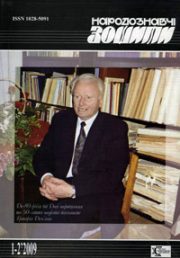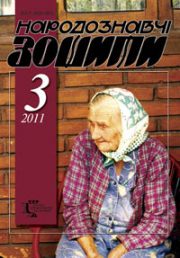The Ethnology Notebooks, 2018, № 5 (143), 1132—1148
UDK 391:746.22.02](477.86)”189/20″
DOI https://doi.org/10.15407/nz2018.05.1132
Received 26.07.2018
ORCID ID: https://orcid.org/0000-0002-8742-4337
Kozakevych Olena Romanivna, Candidate of Sciences in Art Studies, research worker
Folk Art Department
of the Institute of Ethnology of the National Academy of Sciences of Ukraine.
Svobody Avenue 15, 79000, Lviv, Ukraine.
Contacts: e-mail: kozakevych.olena@gmail.com
Abstrakt. On the basis of author`s field investigations, local features of national knitted and lace products in the dress of Hutsuls of Rakhiv district at the end of the XIX — the beginning of the XXI century are considered. The characteristic typological and artistic signs in general and local deletions of separate cells are highlighted. The unique and universal parameters of knitted (“woven”) and openwork artifacts in the context of Hutsul national clothes in chronological order are determined. A number of works, photos, narratives from respondents and local terms were introduced into the scientific circulation.
Keywords: knitting, lace, tradition, typology, local features, shirt, kaptchury, narakvytsi, keptar, serdak, additions, decoration, kytytsi, manufacturing techniques, technological ornament, artistic characteristics.
REFERENCES
Bilan, M., & Stel’maschuk, H. (2001). National costume of Hutsulshchyna in the context of the Ukrainian national wear. In History of Hutsulshchyna (Vol. VI, pp. 213―222). Lviv: Logos [in Ukrainian].
Holovatskyj, Y. (1868). About costumes or folk decorations of Rusyns or Russians in Galicia and northeastern Hungary. Petrograd [in Russian].
Kozakevych, O. (2006). Kosivschyna ― the center of knitting of the XX century. In Works on the Shevchenko Scientific Society. Regional studies (Vol. II, pp. 270―280). Kosiv [in Ukrainian].
Kozakevych, O. (2014). Ukrainian folk lace and knitwear of the late XIX and early XXI centuries: historiography of the issue. The Ethnology notebooks, 5 (119), 951―966. Lviv [in Ukrainian].
Kozakevych, O. (2004). The typology of Ukrainian knitted products of the late XIX and first half of the XX century (on materials of folk costume). Visnyk of Lviv University. Series of art studies, 4, 112―121 [in Ukrainian].
Kozakevych, O. (2005). Kosiv ― the center of knitting of the XX century. Mystetstvoznavstvo’05. 79―87. [in Ukrainian].
Kozakevych, O. (2008). Traditional knitting (petinnia) in Hutsulshchyna at the end of the XIX and XX centuries: history, typology, artistic features. In Gregit (pp.79―87) [in Ukrainian].
Kozakevych, O. (2011). Ukrainian traditional knitted products of the late XIX and XX centuries: local features (based on materials from the western regions). In Zapysky Naukovoho Tovarystva im. T.H. Shevchenka (Vol. CCLXI (261), pp. 503―524) [in Ukrainian].
Kozakevych, O. (2007). Narakvyci. In S. Pavliuk (Ed.), Small Encyclopedia of Ukrainian Ethnology (pp. 373―374 ). Lviv [in Ukrainian].
Kozakevych, O. (2007). Knitted Kapchury. In S. Pavliuk (Ed.), Small Encyclopedia of Ukrainian Ethnology (p. 259). Lviv [in Ukrainian].
Kozakevych, O. (2007). Holyavky. In S. Pavliuk (Ed.), Small Encyclopedia of Ukrainian Ethnology (p. 644). Lviv [in Ukrainian].
Kozakevych, O. (2014). Hutsul folk knitted products of the XIX ― early XXI century: tradition and modernity. In Lemkos, Boyki, Rusyn. History, contemporary times, material and spiritual culture (Vol. V, pp. 603―617).
Słupsk, Zielona Góra, Śvidnik: publishing house of the University of Zielona Góra [in Ukrainian].
Kozakevych, O. (2014). Typology of Ukrainian folk knitted and lace articles of the XIX and early XXI centuries: clothes. The Ethnology notebooks, 6 (120), 951―966 [in Ukrainian].
Kozakevych, O. (2016). Typology of Hutsul traditional knitted products of the late XIX ― early XXI centuries: clothes. In Tradition and the present state of culture and arts . Collection reports and abstracts VІ International Scientific and Practical Conference. Мінск [in Russia].
Kozakevych, O. (2017). Local features of national clothes of “colored” villages of the Nadvirnyanshchyna of the XX ― the beginning of the XXI century: a comparative aspect (on field materials). In Ukrainian phenomenon of Hutsulshchyna: national and European contexts. Materials of the XXI International Scientific Conference. Kolomyia [in Ukrainian].
Kotsan, V. (2012). Traditional folk costumes of Hutsuls of Rakhiv. Uzhhorod [in Ukrainian].
Kotsan, V. (2012). Traditional shoulder and outer clothing of Hutsuls of Rakhivshchyna in the middle of the XIX ― the first half of the XX century. In Yasinya in the noise of centuries. Proceedings of the 1rd Scientific Conference. Yasinia [in Ukrainian].Makovskyj, S. (1925). Folk art of Subcarpathian Rus. Praha [in Russia].
Matejko, K. (1976). Local peculiarities of the Hutsul clothing of the late XIX ― early XX century. In Karpatskyj sbornyk (pp. 57―64). Moskva: Nauka [in Russia].
Matejko, K., & Polians’ka, O. (1987). The clothes. In Hutsulschyna: Historical–ethnographic research (pp. 189―203). Kyiv: Naukova dumka [in Ukrainian].
Pylyp, R. (2012). Traditional embroidery on clothes of Hutsuls of Rakhivshchyna of XIX ― first half of XX century. In Yasinya in the noise of centuries. Proceedings of the 1rd Scientific Conference. Yasinia [in Ukrainian].
Pylyp, R. (2012). Ukrainian embroidery of the Transcarpathians of the XIX ― the first half of the XX century (typology by purpose, artistic and local features). Uzhhorod [in Ukrainian].Polianskaia, E. (1972). Folk clothing of Hutsuls of the Rakhiv district. In Karpatskyj sbornyk (pp. 57―65). Moskva: Nauka [in Russia].
Shmeleva, M. (1948). Types of women’s national clothing of the Ukrainian population of the Transcarpathian region. Sovetskaia etnohrafyia, 2, 130―146 [in Russia].
Kozakevych, O. (2009). Huculszchyna’s Kosiv – the knitting center of Western Ukraine of the XX century. In Lemkos, Boyki, Rusyn. History, contemporary times, material and spiritual culture (Vol. II, pp. 271―279). Słupsk, Zielona Góra, Śvidnik: publishing house of the University of Zielona Góra [in Polish].Oplieshtilova, H. and Babka, L. (2014). The disappeared world of Subcarpathian Rus in the photos of Rudolf Goulka (1887―1961). Praha [in Czech].







